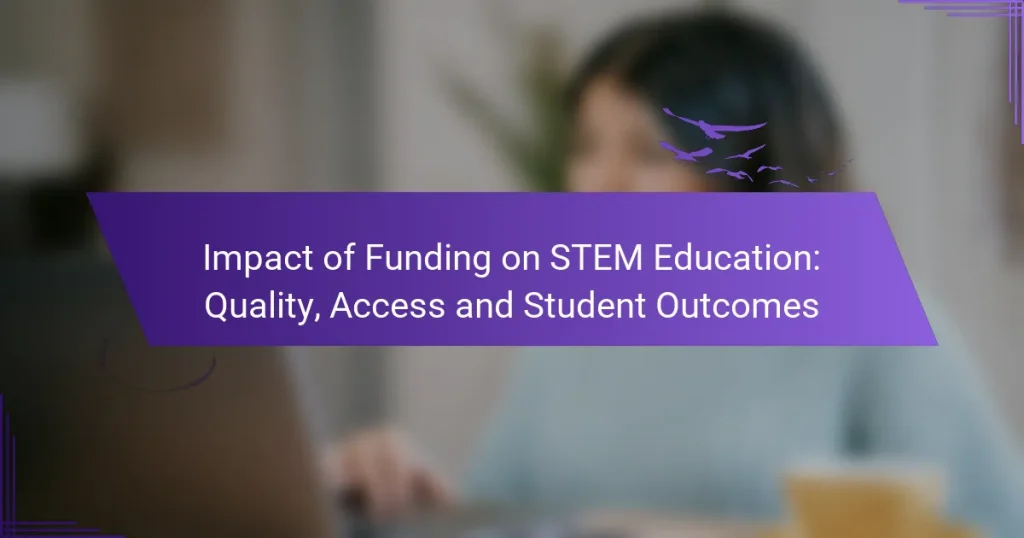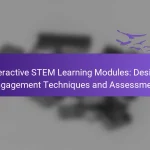The impact of funding on STEM education is profound, as it directly affects the quality of resources, teacher training, and access to advanced technologies. Adequate financial support not only enhances curriculum development but also improves educational opportunities, particularly for students in underserved areas. Ultimately, increased funding leads to better student outcomes by enabling innovative teaching methods and hands-on learning experiences that foster success in STEM fields.

How does funding impact quality in STEM education?
Funding significantly influences the quality of STEM education by providing essential resources, enhancing teacher training, and facilitating access to advanced technologies. Increased financial support can lead to improved curriculum development and better educational outcomes for students.
Increased resources for curriculum development
With adequate funding, schools can invest in high-quality curriculum materials that align with current educational standards. This includes updated textbooks, interactive learning modules, and hands-on laboratory kits that enhance student engagement and comprehension.
For example, a well-funded STEM program might incorporate project-based learning that allows students to tackle real-world problems, fostering critical thinking and collaboration skills. Schools should prioritize funding for curriculum development that reflects the latest advancements in science and technology.
Enhanced teacher training programs
Funding plays a crucial role in providing teachers with ongoing professional development opportunities. Well-supported training programs equip educators with the latest pedagogical strategies and subject matter expertise, which directly impacts the quality of instruction in STEM fields.
Investing in workshops, conferences, and certification courses can help teachers stay current with emerging technologies and teaching methods. Schools should seek partnerships with universities or organizations that offer specialized training in STEM education to maximize the benefits of their funding.
Access to advanced technology and tools
Financial resources enable schools to acquire cutting-edge technology and tools that enhance the learning experience in STEM education. Access to computers, software, and laboratory equipment is essential for students to gain practical skills relevant to the workforce.
For instance, schools can implement coding programs or robotics labs that provide hands-on experience with technology. It is important for educational institutions to allocate funding strategically to ensure that all students have access to these vital resources, bridging the gap between different socioeconomic backgrounds.
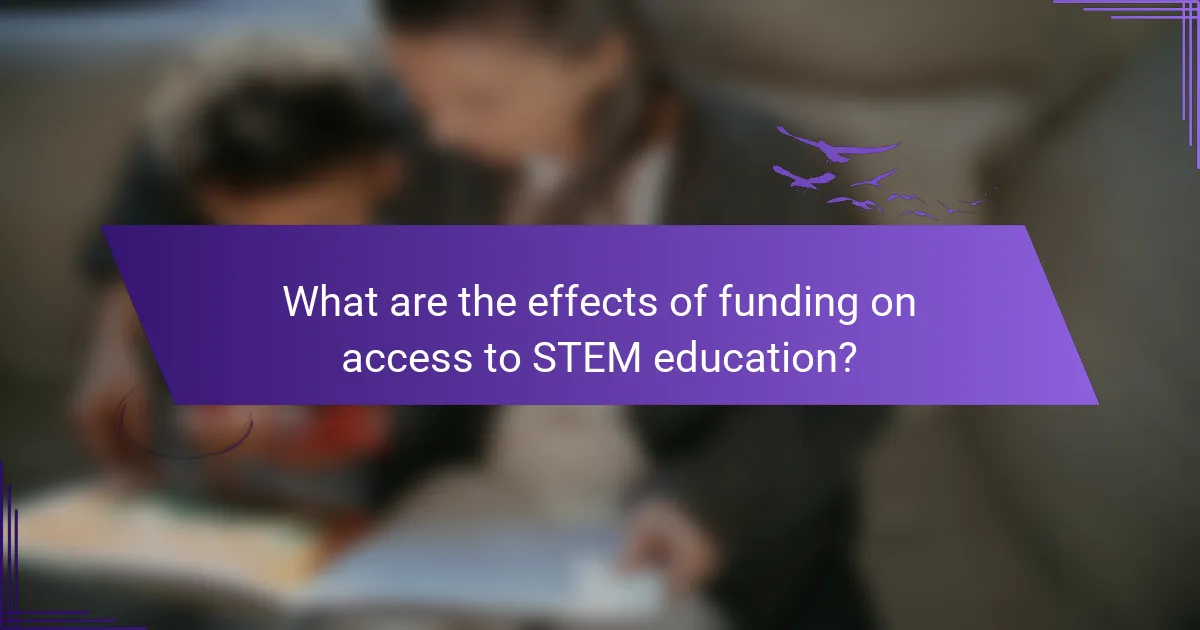
What are the effects of funding on access to STEM education?
Funding significantly enhances access to STEM education by providing financial resources that support various initiatives. Increased funding leads to more scholarships, program expansions, and partnerships, ultimately improving educational opportunities for students, particularly in underserved areas.
Improved availability of scholarships and grants
Increased funding allows educational institutions to offer more scholarships and grants, making STEM programs more accessible to a broader range of students. These financial aids can cover tuition, materials, and other related expenses, reducing the financial burden on families.
For example, many universities now provide targeted scholarships for underrepresented groups in STEM, helping to bridge the gap in participation rates. This not only encourages diversity but also fosters a more inclusive learning environment.
Expansion of STEM programs in underserved communities
Funding plays a crucial role in the expansion of STEM programs in underserved communities, where resources are often limited. With adequate financial support, schools can develop new curricula, hire qualified teachers, and provide essential equipment and technology.
Programs like after-school STEM clubs or summer camps can thrive with proper funding, offering students hands-on experiences that spark interest in science and technology fields. These initiatives can significantly increase student engagement and retention in STEM subjects.
Partnerships with local businesses for funding
Collaboration with local businesses can enhance funding for STEM education, creating mutually beneficial partnerships. Companies often seek to invest in their communities and can provide financial support, internships, or resources that enrich educational programs.
For instance, a tech company might sponsor a coding boot camp at a local high school, providing students with real-world skills and networking opportunities. Such partnerships not only improve funding but also align educational outcomes with workforce needs, preparing students for future careers.
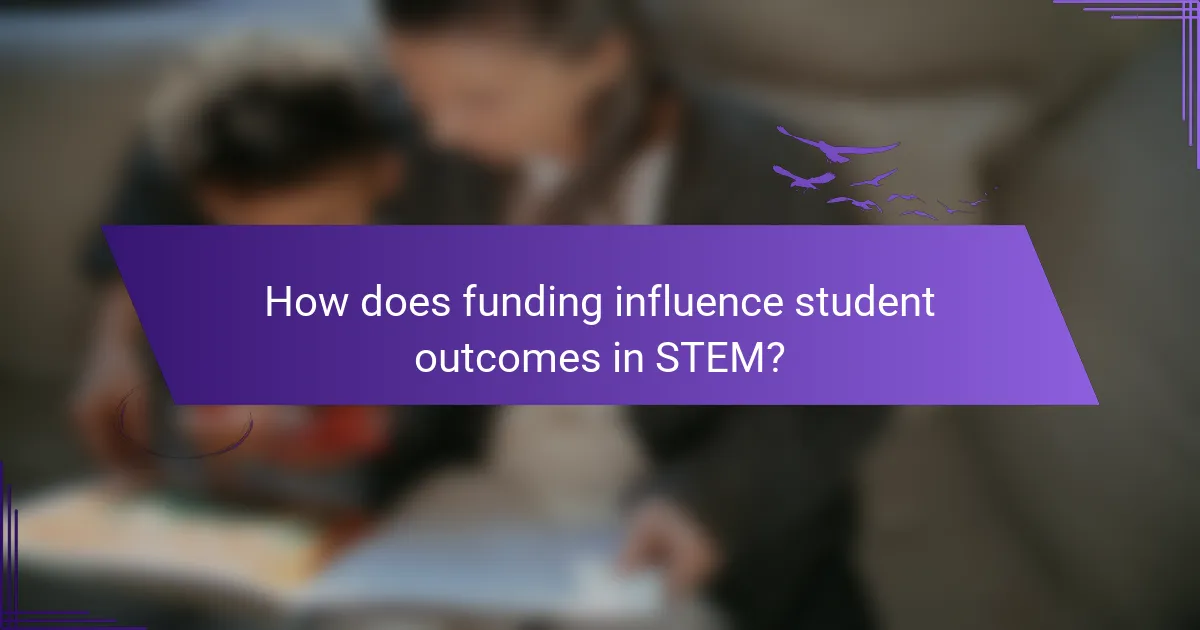
How does funding influence student outcomes in STEM?
Funding significantly impacts student outcomes in STEM by providing essential resources, enhancing program quality, and improving access to educational opportunities. Adequate financial support enables schools to implement innovative curricula, hire qualified instructors, and offer hands-on learning experiences that boost student success.
Higher graduation rates in funded programs
Programs with sufficient funding typically see higher graduation rates among students. This is often due to the availability of resources such as tutoring, mentoring, and extracurricular activities that support student learning and retention. For instance, schools that allocate funds for after-school STEM clubs can engage students more effectively, leading to increased commitment to their studies.
Moreover, funded programs can provide scholarships or financial aid, reducing the economic barriers that might otherwise prevent students from completing their education. This financial support can be crucial for low-income students, ensuring they stay on track to graduate.
Increased student engagement and motivation
Funding enhances student engagement and motivation in STEM fields by allowing for the incorporation of interactive and experiential learning methods. Schools can invest in modern technology, lab equipment, and field trips that make learning more dynamic and relevant. For example, students who participate in hands-on science experiments or coding workshops often exhibit a greater interest in pursuing STEM careers.
Additionally, well-funded programs can attract passionate educators who inspire students through innovative teaching methods. Engaged students are more likely to participate in class discussions, collaborate on projects, and take initiative in their learning, all of which contribute to improved educational outcomes.
Better performance on standardized tests
Students in well-funded STEM programs often perform better on standardized tests compared to their peers in underfunded environments. Access to quality instructional materials, test preparation resources, and personalized support can lead to improved understanding of complex concepts. Schools that invest in professional development for teachers can also enhance instructional quality, which directly impacts student performance.
Furthermore, programs that emphasize critical thinking and problem-solving skills tend to prepare students more effectively for standardized assessments. By focusing on these skills, educators can help students not only perform well on tests but also develop a deeper understanding of STEM subjects that will benefit them in future academic and career pursuits.

What criteria should be considered for STEM funding allocation?
When allocating funding for STEM education, key criteria include equity in access for diverse student populations, alignment with local workforce needs, and the potential for improving educational outcomes. These factors ensure that resources are directed where they can have the most significant impact on both students and the community.
Equity in access for diverse student populations
Equity in access means ensuring that all students, regardless of their background, have the opportunity to engage in STEM education. This involves addressing barriers such as socioeconomic status, geographic location, and cultural differences that may hinder participation.
To promote equity, funding should support programs that target underrepresented groups, including minorities and low-income students. For instance, grants could be allocated to schools in underserved areas to enhance their STEM curricula and provide necessary resources.
Alignment with local workforce needs
Aligning STEM funding with local workforce needs ensures that educational programs prepare students for available jobs in their communities. This requires collaboration between educational institutions and local industries to identify skills gaps and emerging job opportunities.
For example, funding could be directed toward training programs in fields like information technology or renewable energy, which are in high demand. Schools might partner with local businesses to create internships or apprenticeships, providing students with practical experience and enhancing their employability.
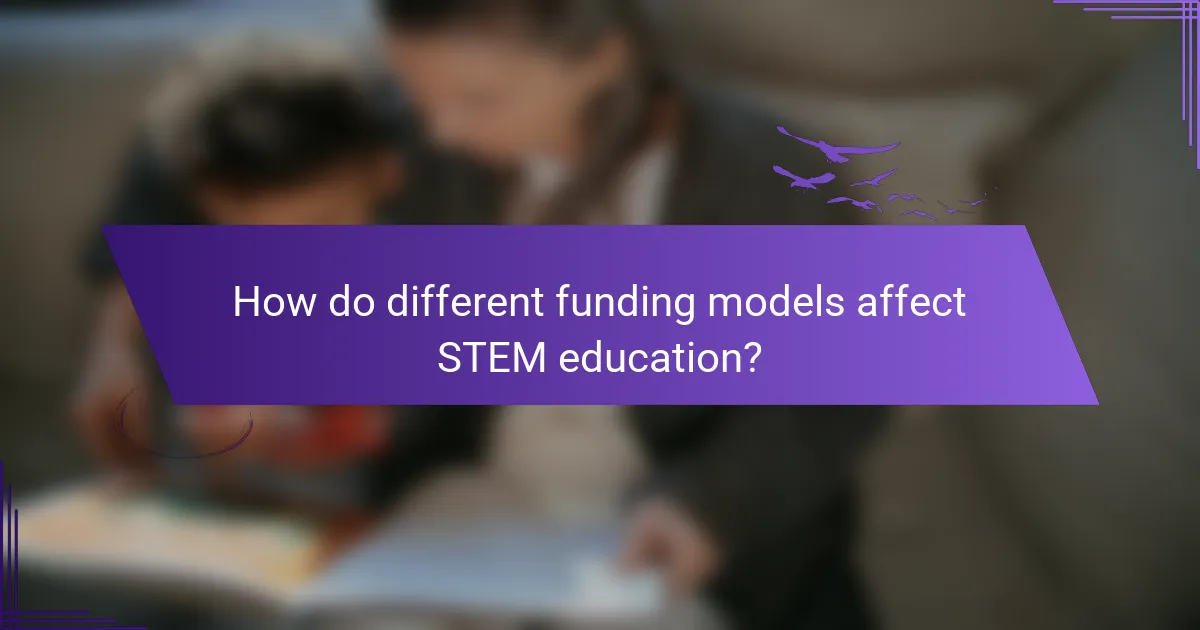
How do different funding models affect STEM education?
Different funding models significantly influence the quality, access, and outcomes of STEM education. Public funding typically emphasizes equity and broad access, while private funding may focus on innovation and specialized programs.
Public vs. private funding impacts
Public funding for STEM education often comes from government sources and aims to provide equitable access to resources across all schools. This funding usually adheres to regulations that promote inclusivity, ensuring that underserved communities receive necessary support.
In contrast, private funding can lead to disparities in STEM education quality. Private grants and donations may allow for advanced technology and specialized programs, but they can also create a divide where only affluent schools benefit, leaving others with fewer resources.
State vs. federal funding differences
State funding for STEM education is typically allocated based on local needs and priorities, which can lead to variability in resource distribution. States may prioritize funding for specific initiatives, such as teacher training or infrastructure improvements, based on regional educational goals.
Federal funding, on the other hand, often comes with specific guidelines and requirements aimed at addressing national educational standards. Programs like Title I provide additional resources for schools serving low-income students, ensuring that federal support targets areas of greatest need.
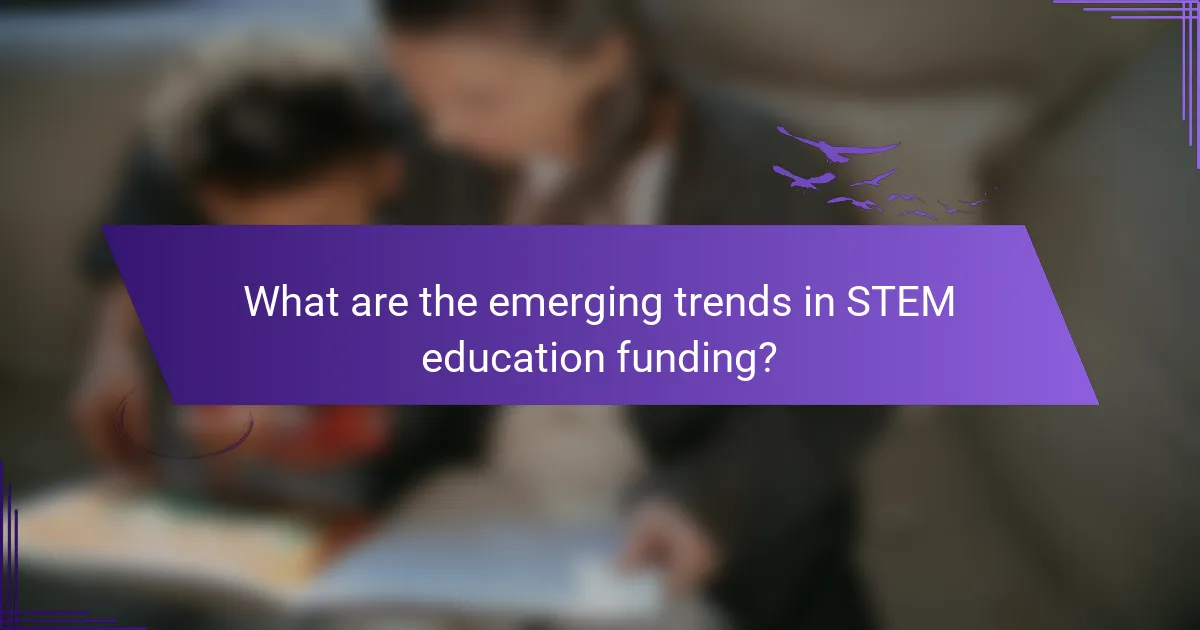
What are the emerging trends in STEM education funding?
Emerging trends in STEM education funding highlight a shift towards more innovative and inclusive financial strategies. These trends focus on sustainability, community involvement, and the integration of technology to enhance educational outcomes.
Increased focus on sustainability in funding
Funding for STEM education is increasingly prioritizing sustainability, reflecting a broader commitment to environmental stewardship. This trend encourages educational institutions to adopt green practices and develop curricula that emphasize sustainability principles.
For example, grants may now require schools to implement energy-efficient technologies or promote environmental science programs. Institutions that align with these sustainable funding criteria can attract more financial support and foster a culture of responsibility among students.
Growth of crowdfunding for educational initiatives
Crowdfunding has emerged as a significant source of funding for STEM education, allowing educators to tap into community resources. Platforms like GoFundMe and Kickstarter enable teachers to raise money for specific projects, such as robotics clubs or science labs, directly from supporters.
This approach not only democratizes funding but also engages the community in the educational process. Schools can leverage social media to promote their campaigns, often achieving funding goals within weeks, which fosters a sense of ownership and involvement among local stakeholders.
Integration of technology in funding strategies
The integration of technology in funding strategies has transformed how educational institutions secure financial resources. Online platforms and digital tools streamline the application process for grants and allow for more efficient tracking of funding usage.
Moreover, technology facilitates data-driven decision-making, enabling schools to present compelling cases for funding based on measurable outcomes. For instance, using analytics to demonstrate the impact of STEM programs can significantly enhance proposals, making them more attractive to potential funders.
